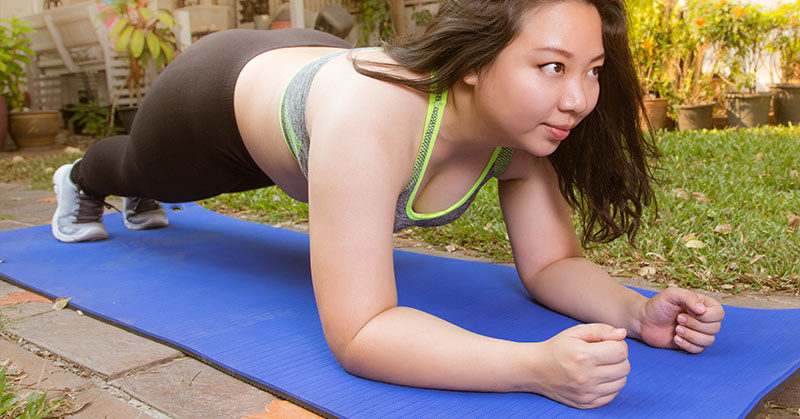Planks have found their place into so many exercise programs, from strength training to boot camp to yoga. They’re a difficult exercise that requires muscular strength and endurance.
In order to reap the benefits of core-training, the plank has to be done correctly. Many people struggle to maintain this position for more than 30 seconds. That doesn’t mean they have to give up. There may be a few reasons holding them back from completing this exercise, and here’s how to fix them
The Benefits of Planks
Core training has been thrown into prominence lately and for good reason. It’s an effective way to improve stability and maintain mobility. Planks work better than crutches and similar exercises since they protect the back and provide many benefits beyond toning abs. They work the entire body.
Planks improve posture by strengthening your shoulders, neck, back, and chest. This prevents you from hunching while sitting or standing. They can also increase your flexibility by lengthening your hamstrings and the arches of your feet.
Additionally, planks can be modified and changed up. Planks could be done on your elbows or your hands, on the floor, an elevated surface, or even against the wall. Start by holding this pose for 15–30 seconds, then slowly increase it. To add an extra challenge to your workouts by practicing active planks, like side planks, one-armed planks, or knee-touch planks. [1]
3 Reasons You Struggle with Planks and How to Correct Them
Geoff Tripp, CSCS, certified personal trainer and head of fitness at Trainiac, came forward to explain what tends to prevent people from planking properly and how to fix it.
Reason #1
Problem: Sagging Hips
Solution: Tighten Your Core
If you have weak core muscles, holding a plank will be difficult at first.
“Poor rectus abdominal and oblique strength limit your ability to properly support the midsection of your plank,” Tripp says. This cause your hips to sag to try and release some of the weight on the abs. However, this ruins the proper form needed for the plank, which results in too much pressure on the lower bank.
“Having a well-balanced strength and conditioning program that is designed to not only develop your plank holds, but also address specific muscle weakness is key,” Tripp says.
Therefore, you can start planking with your hands on a bench or any elevated surface. This makes the position easier and can help you build up the strength to keep your hips level when you try a regular plank. When you do, begin with short reps as you focus on keeping your hips up then gradually increase your time until you pass the 30-second mark. [2]
Reason #2
Problem: Unable to Maintain Neutral Alignment
Solution: Engage Your Glutes and Quads
Many people assume core-strength is only in the abdominals, but this is not the case. The core consists of many muscles from between your shoulder to your knees, and includes your quads and glutes. Therefore, don’t just focus on tightening your abs in a plank; actively squeeze your legs and butt as well.
“Not engaging your glutes and quads will hinder how well you can tuck your pelvis and maintain a neutral spine,” Tripp says. These muscles work together to keep the pelvis in the neutral position, keeping the body in a straight line. This helps stop your hips from sagging as well and protects your lower back.
To engage these muscles, it’s important to develop some body-awareness and training to engage the proper muscles. You could also improve your glute and quad strength and practice their activation by doing reps of squats and lunges. [3]
“I personally like glute bridges and split squats since they work the lower body unilaterally and require mindfulness of your core to maintain balance and a neural body alignment,” Tripp says.
Reasons #3
Problem: Shoulder Blades Popping Up
Solution: Strengthen the Upper Body
In a plank, your shoulder blades should be flat and your back as smooth as a tabletop. If your shoulder blades are sticking up like wings, you need to push harder off the ground. If you are unable to do that, your shoulders may be weak and you need to work on improving your upper-body muscles.
In a plank, many muscles in the upper-body work in tandem to hold the body away from the ground while keeping the shoulder joint maintained. When these muscles are weak, it’s very difficult to hold proper form or a plank at all for very long.
Fortunately, there are many ways to improve upper-body strength. “Any pressing movement will aid in the development of your shoulder and upper body muscles,” says Tripp. He recommends push-ups, since they are really just an active plank. You can try practicing push-ups on your knees, on an elevated surface, or even against the wall. [2]
Sources
- ” The Worthwhile Benefits of Plank Exercises.” Erin Kelly. Healthline. May 29, 2020
- Can’t Hold a Plank for More Than 30 Seconds? Here’s What Your Body Is Trying to Tell You. Jaime Osnato. Livestrong Dec 2019
- ” Why Can’t I Hold a Plank? An Investigation.” Clio Chang. Vice. May 8, 2020

